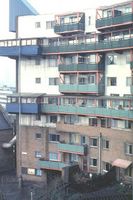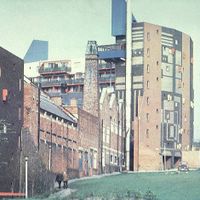Tuesday, March 22, 2005
Like the shaft of an axe

"The job of buildings is to improve human relations: architecture must ease them, not make them worse."
"Architecture, like the shaft of an axe, must beautifully and precisely symbolise its own good reasons for its necessary existence. Insight and sincerity will tell us which reasons are good."
Ralph Erskine
 During a design critique in my second semester of architecture school, my professor suggested that I look at an English housing development known as Byker. It was one of architect Ralph Erskine’s most famous projects, part of a large urban redevelopment in Newcastle-upon-Tyne, England. While my prof made this suggestion because of similarities he saw in the formal (as in relating to form) qualities of my design project and Erskine's design, he unwittingly introduced me to one of the architects whose social conscience and ability to make that conscience manifest in the built environment I have admired since.
During a design critique in my second semester of architecture school, my professor suggested that I look at an English housing development known as Byker. It was one of architect Ralph Erskine’s most famous projects, part of a large urban redevelopment in Newcastle-upon-Tyne, England. While my prof made this suggestion because of similarities he saw in the formal (as in relating to form) qualities of my design project and Erskine's design, he unwittingly introduced me to one of the architects whose social conscience and ability to make that conscience manifest in the built environment I have admired since.Byker is described in Erskine's obituary from the Times Online:
His first work in England to attract widespread attention was the Byker housing near Newcastle, begun in 1960. This was remarkable for the high, protective wall of flats that formed its outward boundary (echoing some of the continuous-wall buildings he had earlier designed for Arctic towns) and for its humane and agreeably relaxed approach to the design of high-density public-authority housing at a time when British work of this kind was being justly criticised for its grim and unsympathetic character.
This "wall" had, however, an important function special to Newcastle: it was created to protect the terraces of flats and houses behind it from the north wind and, no less important, from a ghastly view of asphalt, concrete and cars that would be on Byker’s doorstep should, as planned, the Shields motorway be built. In fact, it never has been, so removing one of the design’s raisons d’être.
Writing at

Erskine has had an immense influence on the Scandinavian architectural debate. He has been faithful to his belief in the development of a good and equal society and he has, without compromises, pledged and fought for the need for social and political awareness in the built environment.
He was a true humanist. His buildings radiate optimism, appropriateness and wit, which endear them to many. His philosophy of work accommodated the climate and the context together with the social and humanistic needs of people. He was concerned that the expression of buildings should engage the general public interest, generate a sense of ownership and appeal to genuine participation.
That humanism and generosity of spirit extended also to the worldwide architectural community. With the money from the many prizes and awards that Erskine won, he and his wife created the Ruth and Ralph Erskine Stipend Fund, administered by the Swedish Association of Architects, which every other year presents the $10,000 Ralph Erskine Award to "an individual, group or organization for innovation in architecture and urban design with regard [to] social, ecological and aesthetic aspects. The efforts of the applicant are to have benefitted primarily the less privileged in society."
 Ralph Erskine died on March 16. He was 91. More writing on and images of Erskine's work can be found at his firm's site: Erskine Tovatt Architects. I'll let him have the last words here:
Ralph Erskine died on March 16. He was 91. More writing on and images of Erskine's work can be found at his firm's site: Erskine Tovatt Architects. I'll let him have the last words here:"Architecture and urban planning — be it at macro or micro level, a private villa or an office block — must not only be a showpiece of design and technology, but also give expression to those democratic ideals of respect for human dignity, equality and freedom that are fostered in our society." Amen.


 Music and Cats
Music and Cats